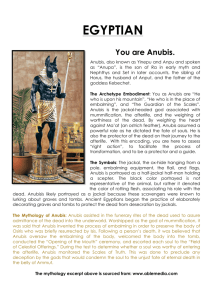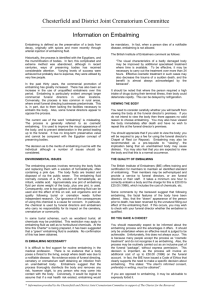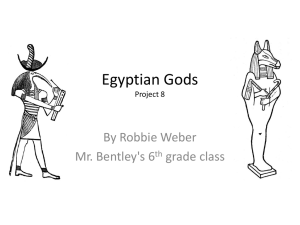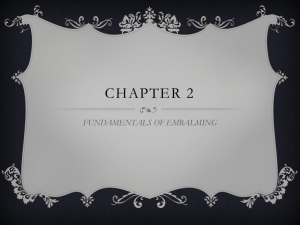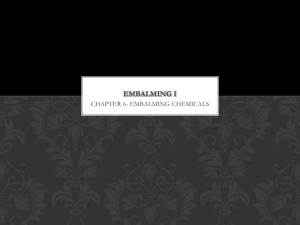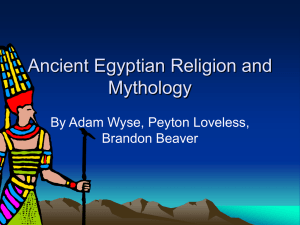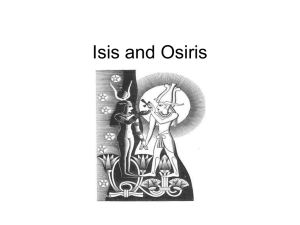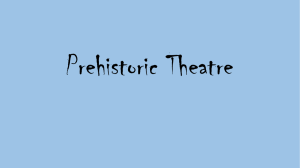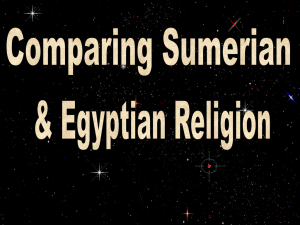The Ancient Egyptians were credited with discovery. Do you think
advertisement
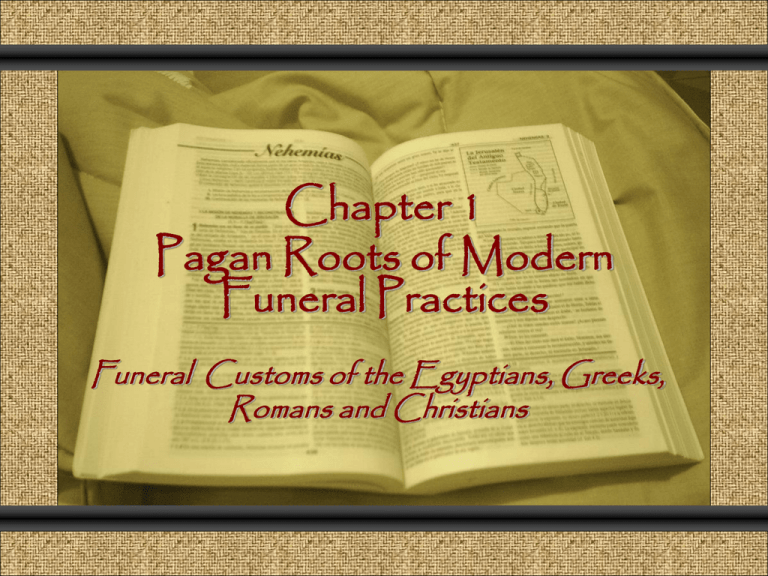
Comunicación y Gerencia Chapter 1 Pagan Roots of Modern Funeral Practices Funeral Customs of the Egyptians, Greeks, Romans and Christians The Ancient Egyptians •The ancient period was from 6000 b.c. to 600 a.d. •During this period it is noted over 400, 000,000 bodies were embalmed!! •The Ancient Egyptians were credited with discovery. •Do you think that the Egyptians were the first civilization to embalm their dead? •No, …since the beginning of time civilizations have tried to preserve their dead. •The Egyptians were credited with discovery simply because they were the first to disclose how it was done. •Why do you think they embalmed the bodies of the dead? •SanitationThe Nile river flooded annually and therefore made it unsanitary for burial in areas close to the river which most of the Egyptians lived . •ReligiousThe Egyptians believed in an afterlife through the cult of Osiris. •OsirisOsiris was the Egyptian god of the underworld and the judge of the dead. •It was believed that the sun was the center of the universe. •When a person died it was their belief that they were to travel to the sun and back in a circuit called the…….. “Circle of Necessity.” •The Egyptians believed that the “Circle of Necessity” journey took 3000 years. •If the body was still preserved after the 3000 years the soul would not forsake the body…Thus the primary reason for embalming was a religious belief. •You should now see why preservation was so important !!!!! Egyptian scene the “Balance”. Egyptian scene the “Balance”. As shown here, the soul's journey toward eternal life in the kingdom of Osiris takes the soul first through a series of portals, where he must answer complex ritual questions posed by the 14 Guardians of the Way, seated above. Then the soul is led by Anubis to the scales, where his heart is weighed in the balance against the feather of Truth. If the heart is heavy with guile and deceit, and the pan that holds the feather rises, Anubis tosses the heart to the monster Am-mit, who devours it. But if the heart is as simple and light as truth itself, the soul's life is assured. After Thoth, at center, records the outcome, Horus leads the soul into the presence of Osiris, seated with Isis and Nephthys behind him, and the four sons of Horus emerging from the lotus at the front of the King's throne. •Anubis~ The God Of Embalming and Mummification. In ancient Egypt, Anubis was the jackal-headed god of embalming who guided the souls of the dead through the underworld kingdom of his father, Osiris. Considered benevolent and good, Anubis was present at the weighing of the dead person's soul, and was also at home in the heavenly sky realms of Ra. His mother was the goddess Nephthys, who along with Isis, Set, and Osiris were the children of the sky goddess Nut and the earth god Geb. Occasionally Anubis is considered the son of Set, but in the more prevalent myth, Nephthys left Set and seduced her sister's husband, Osiris or as some myths say Ra the Sun God. She conceived Anubis, but when he was born she abandoned him in the wilderness. Isis found Anubis with the aid of some dogs, and she raised him. When Anubis grew up, he guarded his foster mother faithfully, and he accompanied Isis and Osiris whenever they journeyed through the world. •Anubis~ When Set murdered and dismembered his brother Osiris, the sisters Isis and Nephthys searched for his body. When they found all the pieces of the Osiris' body, it was Anubis who invented the art of embalming and mummification so that his father (or step-father) could live again and reign in the world of the dead. Anubis is often depicted as a man with the head of a jackal or a dog but is sometimes shown as having the body of a jackal or dog as well. Sometimes he is depicted with one side of his face white or golden and the other black at other times as being completely black but holding a green palm leaf aloft, to symbolize his position in both the heavenly as well as touching on the earthly realms. Anubis was also the God of poisons and medicines due his supplying such things during the mummification of Osiris. Methods of Egyptian Embalming •There were three methods of embalming~ Expensive Medium Priced Inexpensive Methods of Egyptian Embalming •Old school of Embalming •Modern school of embalming Expensive Method of Embalming •The expensive method of embalming consisted of 5 steps 1. The brain was removed through the ear and nose with a hook type of instrument Expensive Method of Embalming 2. The body was eviscerated and the vital organs were placed in jars called canopic jars which were named after the 4 sons of Horus. Who was Horus? Horus •The One Far Above Appearance •man with the head of a hawk •a hawk Horus was a god of the sky •He was probably most well known as the protector of the ruler of Egypt Who was Horus? The Egyptians believed that the pharaoh was the ‘living Horus’. Horus Standard • Horus was the son of Isis and Osiris. After Osiris was murdered by his brother Seth, Horus fought with Seth for the throne of Egypt. In this battle, Horus lost one of his eyes. This eye was restored to him and it became a symbol of protection for the ancient Egyptians. After this battle, Horus was chosen to be the ruler of the world of the living Who was Horus? The Eye of Horus. •One of the best-preserved temples in Egypt was dedicated to Horus. It is located in Upper Egypt at a town called Edfu. The four sons of Horus •Hapi-Baboon/Dog headed-Guardian of the Small Intestines. •Tuamutef-Jackal headed-Guardian of the Lungs and Heart. •Qebehsenuef-Falcon/Hawk headed-Guardian of the Liver and Gallbaldder. •Mestha-Human headed-Guardian of the Stomach and Large Intestine. Expensive Method of Embalming 3. The body was then soaked in a natronic (sodium salt). During this process the finger and toenails fell off, which were sewn back on with golden thread which added to the cost of the embalming. Expensive Method of Embalming 4. After 20-70 days of soaking in the natronic solution, the body was removed and then dried in the sun. 5. The last step was, the body was bandaged and spiced. Up to 1,200 yards of 3 ¼ inch cloth was used. This entire process took up to 120 days to complete!!!!! Expensive Method of Embalming This method would have cost about $5000.00 in U.S. money today. What percent of Egyptians do you think were embalmed with this method? Expensive Method of Embalming ~Only about 2%! How does that correlate with our society today? Medium Priced Method of Embalming •This medium priced of embalming only consisted of three steps. 1. Cedar oil was injected into the abdominal cavity in order to dissolve and dehydrate internal organs. 2. The body was pickled in the natronic solution for 70 days. Medium Priced Method of Embalming 3. The body was then dried in the sun and returned to the family. At this point the family would bury their family member in a selected place. What percent of Egyptians were embalmed with this method? Medium Priced Method of Embalming Only about 18% were embalmed with this method. This method cost about $1200.oo in U.S. money today. Medium Priced Method of Embalming This leaves about 80 % of the Egyptian population to be embalmed with one of the 3 inexpensive methods. Inexpensive Methods of Embalming 1. The body was pickled in a natronic solution. 2. The body was tarred. 3.The body was simply tanned Why do you think the Egyptians were so successful with their embalming methods??? Embalming Specialists 1. The Kher-heb, also known as the priest was in charge of the Necroplis (City of the Dead). He was the supervisor, but did not touch the bodies because he was considered a holy man and the body was thought unclean. Embalming Specialists 2. The Scribe, also known as the lawyer. He drew the line of the place of the incision on the abdomen. Embalming Specialists 1. The Dissector, also known as the paraschisties . He was the one who made the incision through which the vicera were removed. His duties were considered taboo and he was stoned after each performance of his duties. It was severe at first but in later periods was merely a token ritual. Embalming Specialists 1. The pollinctor, also known as the Apothecary. He was the one who mixed all of the medicines and materials to be used for the embalming process. Where else have you heard the term Apothecary? Embalming Specialists 1. The Embalmer, also known as the Surgeon or Anatomist. He was in charge of the actual embalming. His duties also included the wrapping that mummies are known for. This would then make you a “Post Mortem Vascular Surgeon”. Egyptian things to remember. 1. The basic reason underlying the practice of mummification was the belief that it was necessary to preserve the body in the most perfect form that it may be rejoined with the spirit. 2.The Egyptians were mummified as a matter of custom. 3. The Egyptian embalmers belonged to the priestly class….. Embalming was a religious ritual as well as a physical operation. From the earliest times until now, Egyptian embalming has continued to rouse lively interest and admiration, and from Ancient Egypt to present, neither the idea nor the practice of embalming has ever been lost, nor for that matter, was there ever an eclipse of knowledge as to the general proceedure wich the Egyptians used. Lets now take a break and we’ll come back and get into the Ancient Greek Civilization.

